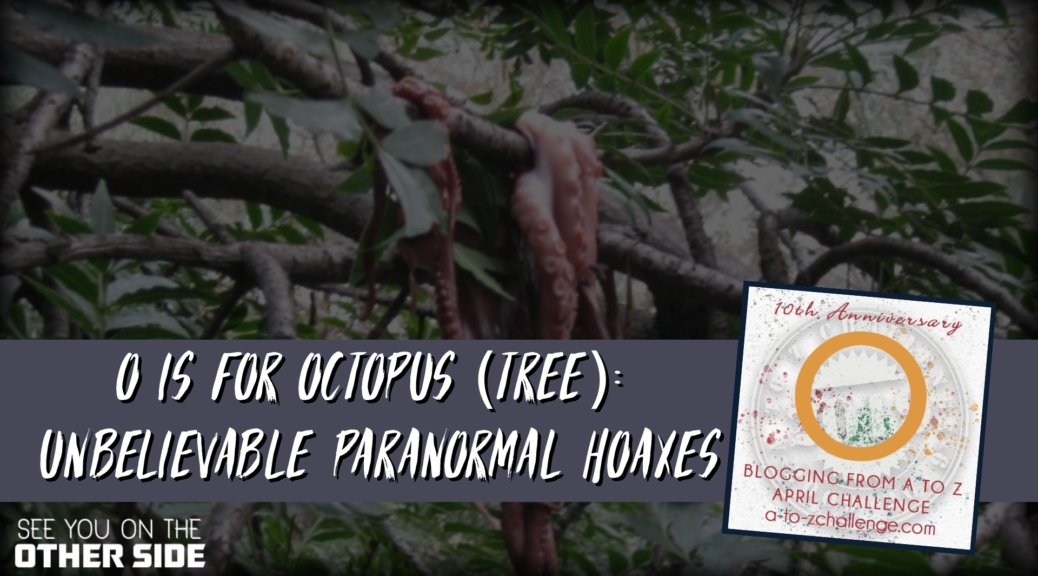They say that seeing is believing, but that isn’t really true when it comes to the paranormal or supernatural. A long history of hoaxes and the prevalence of photoshop has lessened the ability of a picture to paint a believable thousand words. Today, witness testimonies and recordings of strange noises seem to inspire more belief in something not seen than a glossy 8×10.
But why don’t we believe in photos anymore? Is it because so many have been faked? Or is it because we have been so quick to believe them? To really understand the power a photo used to have, we need to look back in time, to simpler times…
In 1998, a hoax that is sadly forgotten today was launched–the story of the Pacific Northwest Tree Octopus (Octopus paxarbolis). Now, before you roll your eyes and think that this was not a successful hoax (or else, you’d remember it) consider this: Snopes.org, once revered as the go-to site on the internet for debunking hoaxes and half-truths felt compelled, in 2014, to explain to the public that the Tree Octopus wasn’t real. That’s right, sixteen years later, some people still wondered if there really were Tree octopi—even though the webpage asking for help saving them explaining their major predator was Sasquatch.
What is a tree octopus? you might be wondering. Well, according to the official website (https://zapatopi.net/treeoctopus/) this gentle cephalopod hails from the rainy forests of the Olympic Peninsula, on the Eastern side of the Olympic mountain range, residing both in fresh water and in the wet canopy of the forest. Its natural predators include house cats, the bald eagle, and sasquatch.
Yes, sasquatch.
Okay, so now you might be wondering how could anyone believe that an octopus could live on land and in fresh water, and that the rainy season of the Pacific Northwest is what allowed its continued existence.
Before you judge a whole generation, take into account the era this took place in.
In 1988, the USAF revealed the existence of the F-117 Stealth Fighter, an “invisible” plane.
In 1989, Bob Lazar came forward, claiming to have reverse-engineered UFOs at the then-highly classified Area 51 military base at Groom Lake, Nevada.
In 1993, The X-Files premiered on television, bringing conspiracies, UFOs and the paranormal into the popculture mainstream.
In 1995, Ray Santelli presented his Alien Autopsy film, which purported to show the examination of an alien body recovered from a UFO crash. (This wasn’t revealed to be a hoax until 2006).
In 1999, the year following the Tree Octopus’ internet debut, audiences were terrified with the “found footage” film, The Blair Witch Project, many initially believing the film was based on true events.
And let’s not forget, the Internet was epically exploding onto the scene, worldwide, in the 1990s, allowing people to not only get information previously hidden in libraries around the globe, but to share reports of the strange and unusual. 1995, for example, saw the formation of the Bigfoot Research Organization.
You also need to remember a similar hoax, revealed in 1993, that was much older: the Surgeon’s Photo.
You might not know it’s name, but this iconic black-and-white image of the Lochness Monster’s head and neck sticking out of the water is known around the world, even today. Despite the fact that it was entirely a hoax, perpetrated by a conspiracy of three men, it is still cited when the Lochness Monster is discussed. The revelation it was a hoax did not diminished belief in Nessie.
According to the website The Unmuseum, Nessie’s most famous photo happened like this:
A man named Duke Weatherell wanted revenge on the London Daily Mail newspaper. This was because in 1933, they had hired him to find the Lochness Monster. He found footprints, made casts and size estimates and sent them off to the London Museum of Natural History. Later, it was discovered Weatherell had been hoaxed himself by locals—the footprints were frauds. The paper who hired Weatherell in turn ridiculed the man and humiliated him.
Fast forward to April 1934, and Colonel Robert Kenneth Wilson, a physician (and surgeon), presented the famous Nessie photo we’re talking about. This “proof” of Nessie remained contested, but believed, for decades. It wasn’t until 1993 that the full story came out, thanks to the work of David Martin and Alastair Boyd., who spoke to one of the men really responsible for the Surgeon’s photo, and who confirmed it was indeed a hoax.
Christian Spurling, stepson of Weatherell, admitted he’d made the “monster” out of some plastic and a clockwork, tinplate, toy submarine at his father’s request. Weatherell and his son actually took the completed faux Nessie out and photographed it. But they needed help disseminating the photo, since Duke had already been thoroughly discredited. They enlisted the aid of Maurice Chambers, who in turn contacted Colonel Wilson, who brought the photo forward and claimed credit for taking it.
Just five years after Nessie’s most famous mugshot was revealed to be a hoax, Lyle Zapato brought the plight of this Tree octopus to world attention with the creation of the website dedicated to saving it and used a similar methodology to fool people: he faked some photos (e.g. by placing a dead octopus in a tree and snapping some pics).
Today, the Tree Octopus is largely forgotten–a hoax when hoaxing was significantly harder to do. Hopefully, it and the surgeon’s photo have taught us all a valuable lesson: Don’t believe everything you see.
